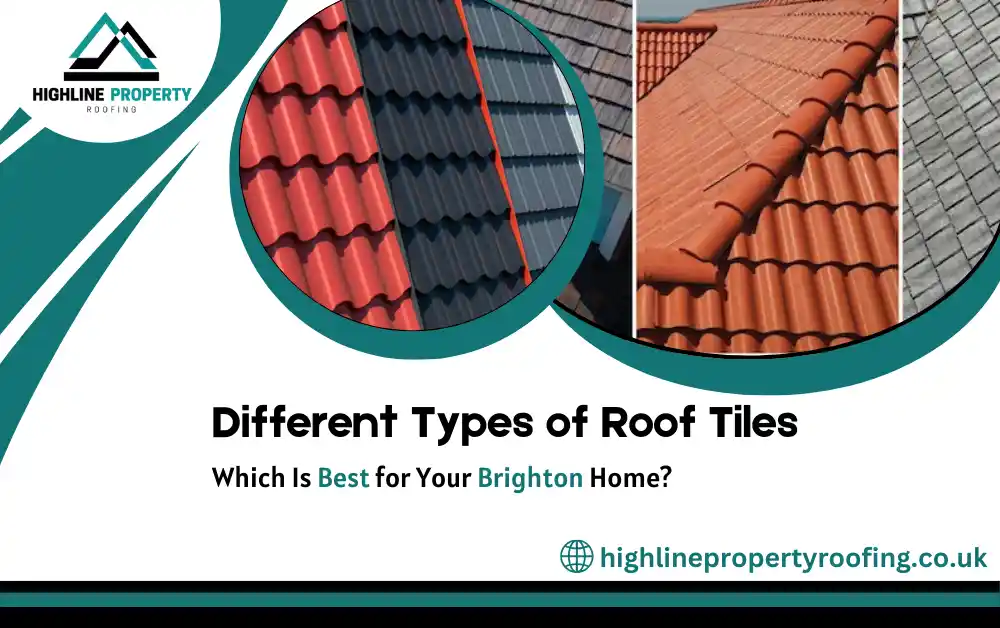Warning: Undefined array key "style" in /home/u595483593/domains/highlinepropertyroofing.co.uk/public_html/wp-content/themes/pearl/partials/header/elements/menu/menu.php on line 79
Warning: Undefined array key "style" in /home/u595483593/domains/highlinepropertyroofing.co.uk/public_html/wp-content/themes/pearl/partials/header/elements/menu/menu.php on line 90
Different Types of Roof Tiles: Which Is Best for Your Brighton Home?

When selecting the finest roofing material for your house, it’s essential to recognise the different types of roof tiles. Brighton’s seaside climate necessitates long-lasting, weather-resistant roofing solutions that can tolerate wind, rain, and occasional salt exposure. In this article, we’ll discuss the various types of roof tiles and their suitability for homes.
Different Types of Roof Tiles
1- Slate Roof Tiles
Slate Roof Tiles are a popular choice because of their timeless appearance and outstanding durability. They are ideal for traditional homes, particularly in conservation zones where aesthetics are essential.
Pros:
- Natural and environmentally friendly.
- They resist water absorption, making them suitable for damp environment.
- With careful upkeep, it will last for more than 100 years.
Cons:
- Expensive to install and repair.
- Heavy, necessitating a sturdy roof structure.
2- Clay Roof Tiles
Another traditional alternative is clay roof tiles, which are distinguished by their reddish-orange colour. Clay roof tiles are commonly seen in homes in Brighton’s historic areas, giving them charm and character.
Pros:
- Highly durable and weather-resistant.
- Excellent thermal insulating capabilities.
- Available in a variety of forms and finishes.
Cons:
- Expensive.
- Fragile and prone to shattering under high impact.
3- Concrete Roof Tiles
Concrete Roof Tiles are a good option for homeowners who want to strike a balance between cost and durability. Due to their durability and affordability, They are perfect for modern homes in Brighton.
Pros:
- Affordable compared to slate and clay.
- Versatile, replicating the appearance of different materials.
- Resistant to severe weather conditions.
Cons:
- Heavier than other materials.
- It can fade with time.
4- Composite Roof Tiles
Composite roof tiles are constructed from a combination of plastic, rubber, and slate dust. They are a modern yet environmentally friendly alternative for homeowners.
Pros:
- Lightweight and easy to install.
- Resistant to weather, UV radiation, and moss growth.
- Eco-friendly alternatives are available.
Cons:
- It may not have the conventional attractiveness of natural materials.
- Costs vary according to quality.
5- Metal Roof Tiles
Metal roof tiles have a clean and contemporary appearance. They are ideal for homes along the shore since they are resistant to sea air.
Pros:
- Lightweight and durable.
- Excellent corrosion and salt resistance, making it superb for Brighton’s coastal surroundings.
- Recyclable and eco-friendly.
Cons:
- It may be noisy during heavy rain.
- Easily dented by hail or debris.
- Metal Roof Tiles are ideal for homes along the shore since they are resistant to sea air.
6- Solar Roof Tiles
Solar Roof Tiles blend functionality and innovation to provide energy efficiency. Brighton residents who value sustainability may find Solar Roof Tiles to be a worthwhile investment.
Pros:
- Produce renewable energy and lower utility expenditures.
- The sleek design merges harmoniously with the roof.
- A long lifespan requires little care.
Cons:
- High initial cost.
- An expert must complete the installation.
7- Copper Roof Tiles
Copper roof tiles are noted for their distinctive, rich appearance, which helps houses stand out.
Pros:
- Create a gorgeous antique over time.
- Extremely strong and resistant to corrosion.
- Lightweight and straightforward to install.
Cons:
- Expensive.
- Limited availability.
Which Roof Tile Is Best for Your Brighton Home?
The right choice depends on your home’s style, budget, and Brighton’s specific weather challenges. Here’s a quick comparison:
| Roof Tile Type | Best For | Key Feature |
| Slate Roof Tiles | Traditional Brighton homes | Longevity and elegance |
| Clay Roof Tiles | Historic properties | Thermal insulation |
| Concrete Roof Tiles | Modern homes | Affordability and durability |
| Composite Roof Tiles | Eco-conscious homeowners | Lightweight and versatile |
| Metal Roof Tiles | Coastal properties | Corrosion resistance |
| Solar Roof Tiles | Sustainable living enthusiasts | Renewable energy generation |
| Copper Roof Tiles | Luxury and high-end properties | Unique aesthetic appeal |
Conclusion
Choosing the best roofing material for your Brighton home involves weighing aesthetics, durability, and cost. Whether you opt for Slate Roof Tiles, Clay Roof Tiles, or innovative Solar Roof Tiles, ensuring the material suits your home’s style and the city’s weather is crucial. Consulting a roofing company in Brighton can help you select the best option based on your needs, ensuring quality installation and long-term performance.
By understanding the different types of roof tiles, Brighton homeowners can make an informed decision that enhances their property’s longevity and appeal.
FAQs
1- Are metal roof tiles suitable for Brighton’s coastal climate?
Yes, Metal Roof Tiles are highly suitable for Brighton’s coastal climate. They are resistant to corrosion caused by salt air, lightweight, durable, and ideal for properties near the seafront.
2- What is the lifespan of concrete roof tiles?
Concrete Roof Tiles typically last 40–60 years, depending on maintenance and weather conditions. Their durability makes them a popular choice for Brighton’s modern homes.
3- What roofing material is best for Brighton’s historic homes?
For Brighton’s historic homes, Slate and Clay Roof Tiles are excellent choices. They maintain the aesthetic integrity of traditional architecture while providing durability.
4- What are the most durable roof tiles for Brighton homes?
Slate and Metal Roof Tiles are the most durable options. They offer excellent resistance to harsh weather and a long lifespan, making them ideal for Brighton’s coastal environment.
